Buyer Intent Keywords: What They Are & How to Find Them
Gabriela Jhean
Understanding what people are looking for when they search online is the cornerstone of effective SEO.
Search intent helps you decipher this, revealing the true purpose behind a search query.
For businesses, buyer intent keywords—those that signal a strong purchase desire—are crucial for driving conversions.
But what exactly are buyer intent keywords? And how can you find them?
In this post, we’ll break down buyer intent keywords, explain why they matter for your business, and guide you through the process of finding them.
Table of Contents
What Is Search Intent?
Search intent is the underlying reason why someone performs a search. It helps you understand the purpose behind a search query.
For example, what is the searcher looking for? Are they seeking information, exploring options, or ready to buy?
Knowing this information helps you create content that truly resonates with your audience.
There are four primary types of search intent:
- Informational: The searcher wants to learn something new or find information about a topic.
- Navigational: The searcher wants to find a specific website or page.
- Commercial: The searcher is exploring options and considering a purchase.
- Transactional: The searcher is ready to buy and is looking for a place to do so.
By deciphering search intent, you can determine what the user is looking for and align your content with their needs and expectations.
What Are Buyer Intent Keywords?
Buyer intent keywords are search terms that signal a strong purchase desire.
They reveal that the user is actively considering or researching a product or service.
Buyer intent keywords consist of both commercial and transactional intent. These keywords align with the mid to late stage in the customer journey, indicating a high likelihood of conversion.
Here’s a brief explanation of each:
- Low-intent keywords, also known as commercial keywords, suggest a general interest in a product or service. Users at this stage are exploring options and comparing alternatives. These keywords often include terms like “best,” “compare,” “review,” or “vs.”
- High-intent keywords, or transactional keywords, demonstrate a clear intent to buy. Users with these keywords are ready to make a purchase and are actively searching for places to buy. These keywords often include terms like “buy,” “purchase,” “order,” “discount,” or “coupon.”
By understanding the difference between low and high-intent keywords, you can tailor your content and marketing efforts to attract the right audience at the appropriate stage of the buyer’s journey.
Why Do Buyer Intent Keywords Matter?
Understanding and targeting buyer intent keywords is crucial for a business’s success.
By focusing on these keywords, you can:
- Increase conversion rates: People searching with buyer intent keywords are more likely to make a purchase, leading to higher conversion rates.
- Improve ROI: Your marketing efforts become more efficient as you target a highly qualified audience.
- Enhance customer experience: By providing relevant content and offers aligned with buyer intent, you create a better customer experience.
- Gain a competitive edge: Identifying and capitalizing on buyer intent keywords can set you apart from competitors.
How to Find Buyer Intent Keywords
Now that you understand the importance of buyer intent keywords, let’s see how to find them using keyword research tools.
1. Brainstorm Keywords
The first step is quick and easy.
Jot down a list of keywords related to your business or industry.
For example, let’s imagine I’m a ceramics artist who sells her pottery online. Some of my keywords might include:
- Handmade pottery
- Ceramic coffee cup
- Ceramic ice cream bowl
Don’t overthink it. Just write anything that comes to mind.
2. Enter Your Keywords Into a Keyword Research Tool
Now, you’re going to plug these ideas into a keyword research tool.
For our demonstration, I’m going to use Semrush.
(If you don’t have a Semrush account, you can sign up for a 7-day free trial.)
First, navigate to the Keyword Overview tool and enter your keyword. I’m using the first keyword in our earlier list, “handmade pottery.”
Semrush will generate several keyword insights, including the Intent. In our example, we see that our keyword has commercial intent.
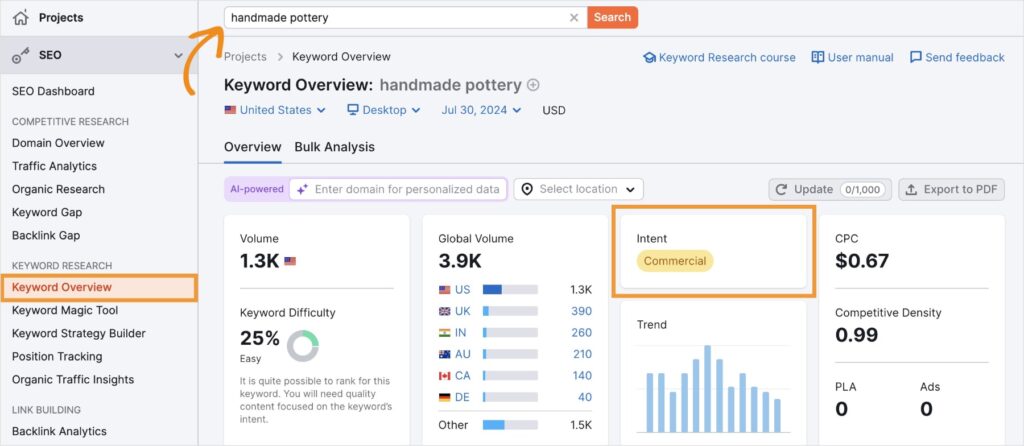
From here, I’d like to get more keywords and their search intents.
Let’s move on to the next step.
3. Find Related Keywords With Buyer Intent
When you’re on the Keyword Overview page, scroll down until you see Keyword Ideas.
Click View all keywords.
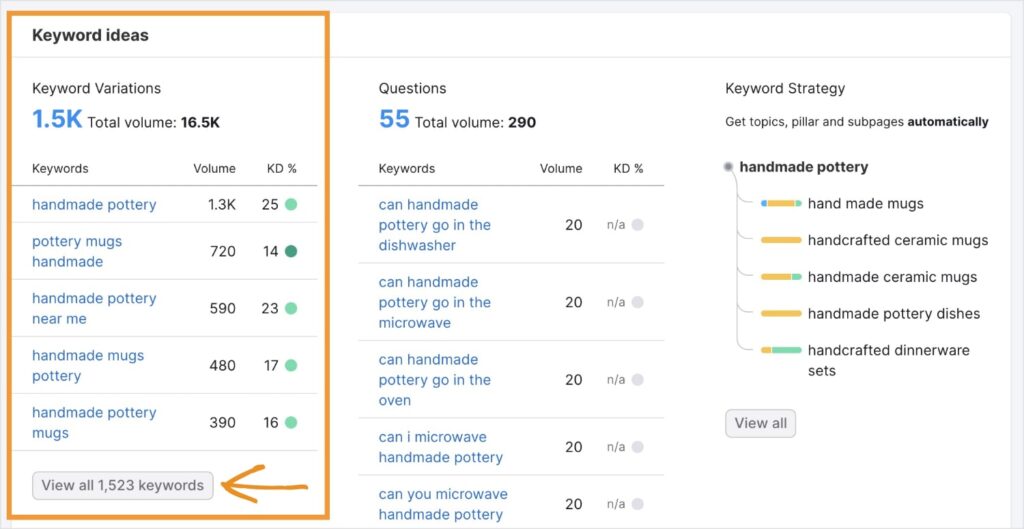
This action will take you to the Keyword Magic Tool, where you will get a list of related keywords and insights.
In the example below, Semrush found 1.5K related keywords. We also see that the first results have commercial and transactional intent.
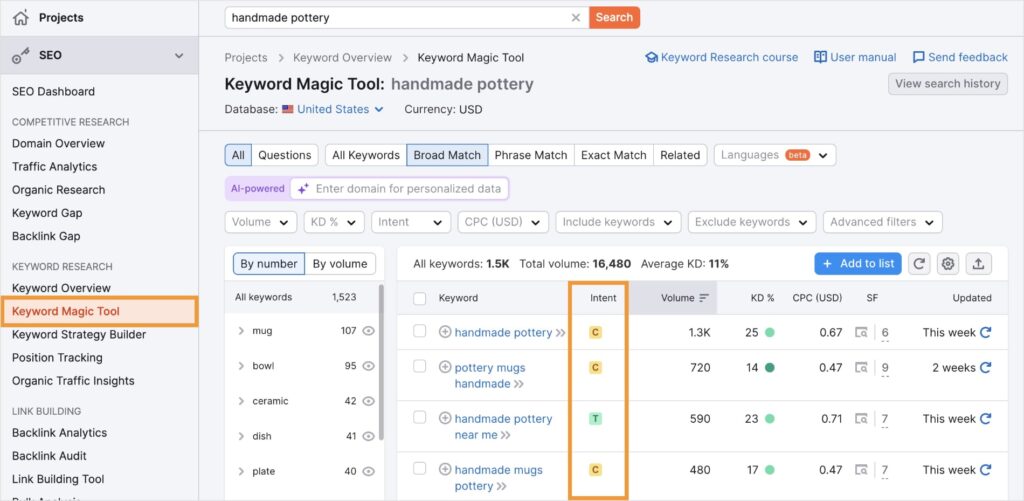
To ensure we’re only looking at buyer intent keywords, I’m going to apply a filter.
Click Intent and select Commercial and Transactional from the list of options. Then, hit Apply.
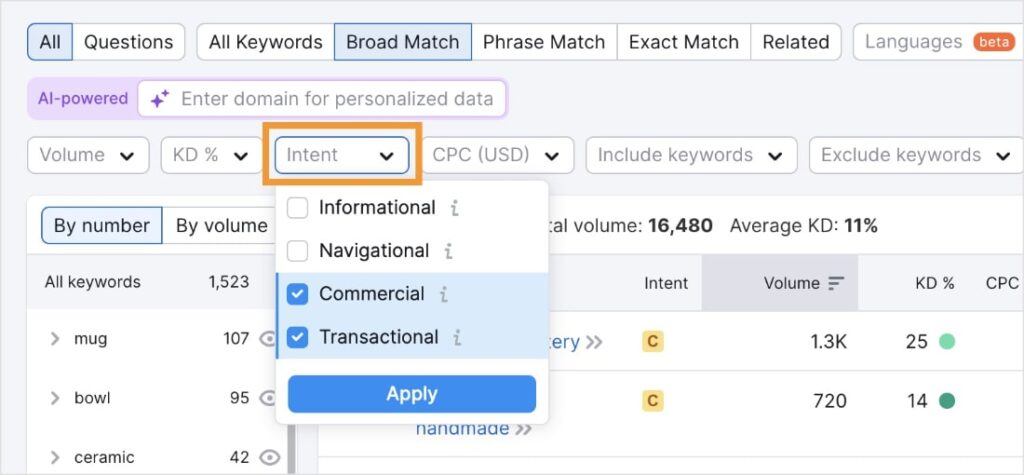
I now have a report of 104 buyer intent keywords related to my original search for “handmade pottery.”
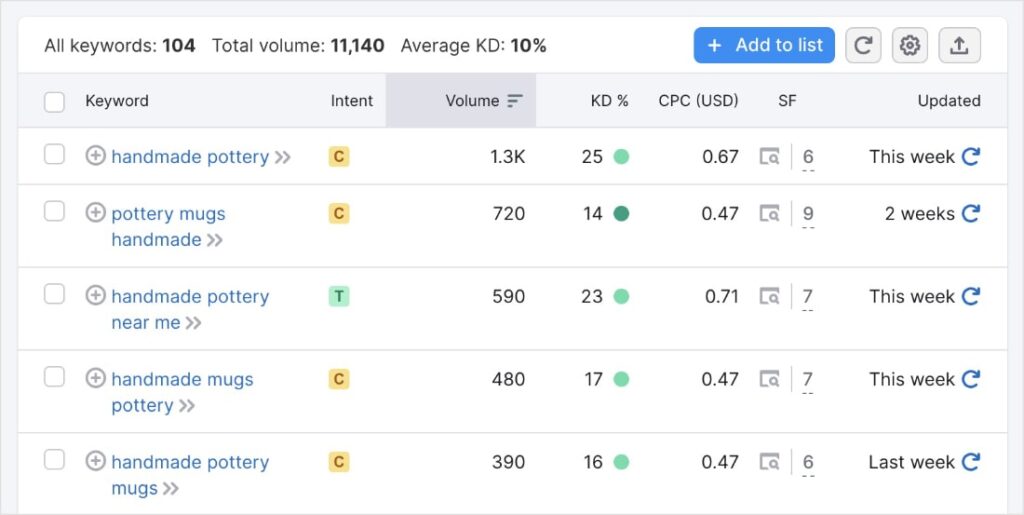
What’s even better is that they all have a low keyword difficulty (KD), meaning they’re easy to rank for. (If this wasn’t the case, we could have applied another filter to exclude high KDs.)
Now, you can save these keywords to lists or export the report to your computer.
And there you have it!
You have successfully generated over a hundred buyer-intent keywords. And that was just from one of our keyword ideas!
Rinse and repeat to get even more.
Now, let’s check out another tool that makes this process even faster.
Finding High-Intent Keywords in LowFruits
If you’re not familiar with LowFruits, it’s a keyword research tool designed to help small business owners find low-competition keywords.
These are keywords that are easy to rank for, meaning you don’t need to have a lot of domain authority, backlinks, etc.
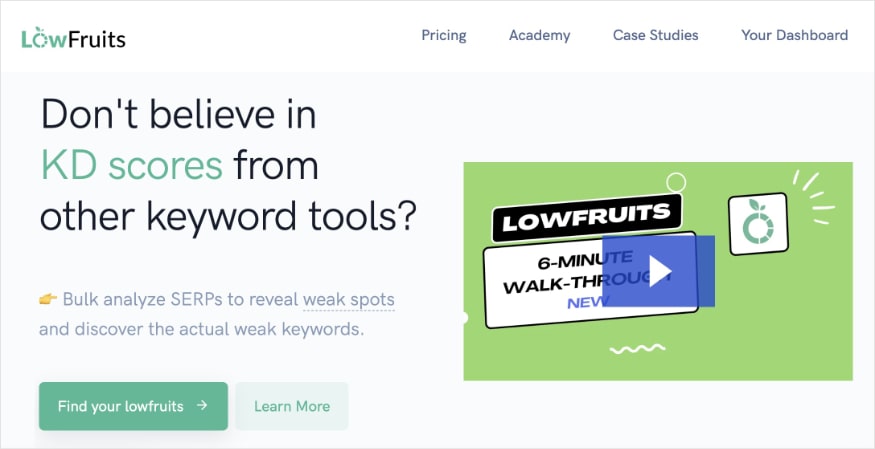
To replicate this process in LowFruits, head on over to the KWFinder. This tool is located in the left menu.
Then, add your keyword.
We’ll use “handmade pottery” again.

You can also change the country and language.
Once you’re ready, click Search.
KWFinder will generate a report that you can access in one of two ways:
- Access all keyword ideas (and manually select which ones to analyze).
- Access all keyword ideas + analyze all high-intent keywords at once.
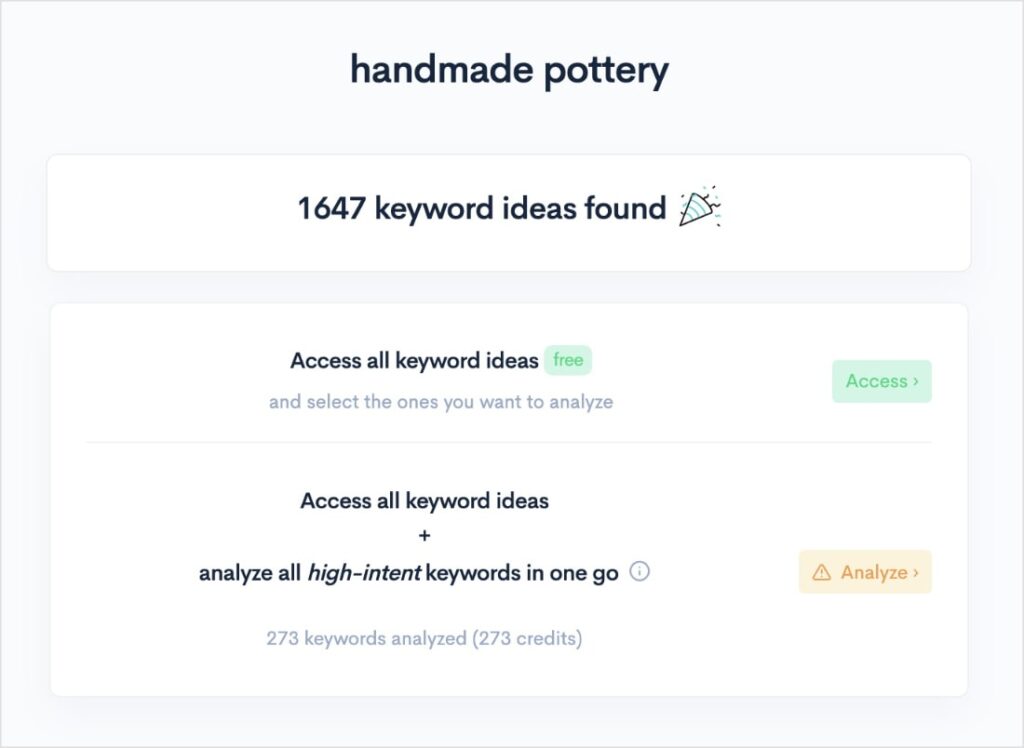
I’m going to select the second option because this will give us valuable keyword insights (like search volumes and weak spots) for all high-intent keywords, which are the ones we’re interested in.
(LowFruits uses a credit system, so if you’re low on credits, go ahead and choose the first option. You can add a high-intent filter after.)
In LowFruits, high-intent keywords have modifiers like:
- How to
- Why
- Can
- Best
- Alternative
- Ideas for
These modifiers produce buyer intent keywords, which is what we’re after.
Once your report is ready, you’ll reach a screen that looks like this:
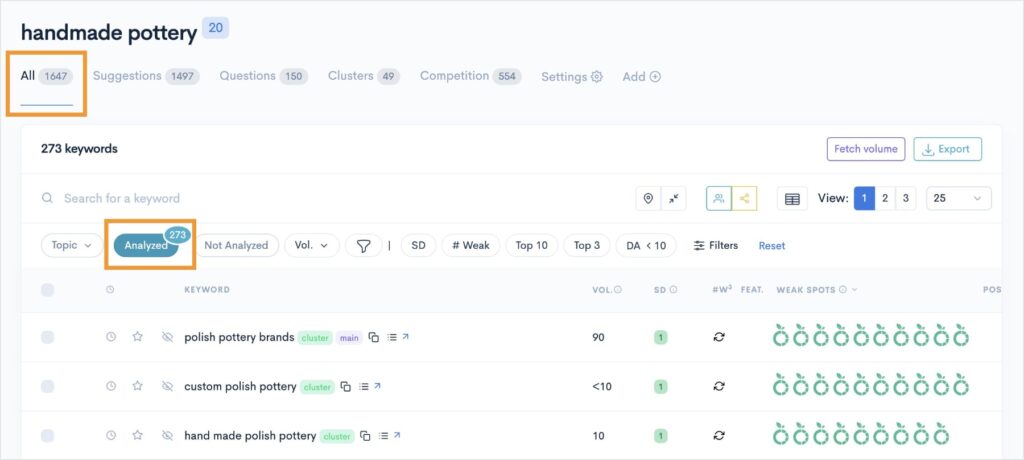
There are several views available, but here are two key ones:
- All: This is a list of all keywords generated for your report.
- Analyzed: This is a list of all analyzed keywords. Since I chose to analyze high-intent keywords when creating this report, I will use this view.
The Analyzed tab gives me 273 high-intent keywords.
Now, since I’m probably a small business, I don’t necessarily care for keywords with high difficulty. Instead, I’d like to focus my SEO efforts on keywords that I can actually rank for.
To curate my keyword list, I’m going to use a filter on the SERP Difficulty Score (SD).
(This is the LowFruits equivalent to Semrush keyword difficulty.)
I set SD to 1, and then click Apply.
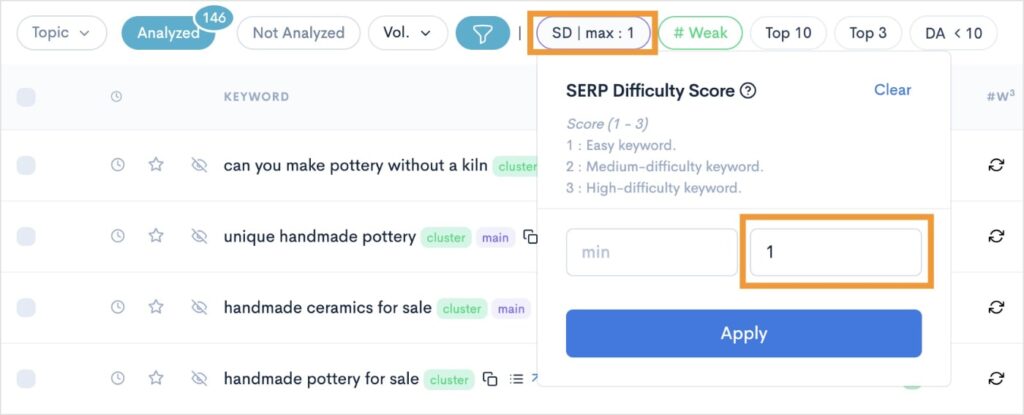
We now have a report of 146 high-intent keywords that are easy to rank for.
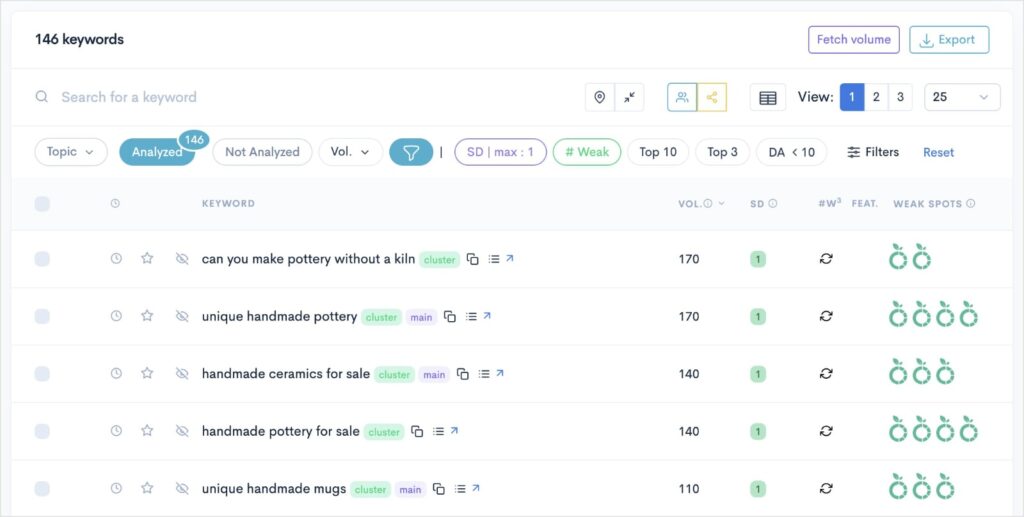
Like Semrush, you can add these to keyword lists or export to your computer.
Now, here’s where it gets really interesting:
In addition to finding buyer intent keywords with low SDs, LowFruits also shows how many weak spots there are on the SERP for any given keyword.
Weak spots are competitors with low domain authority, and they’re symbolized by the green icons in the right column.
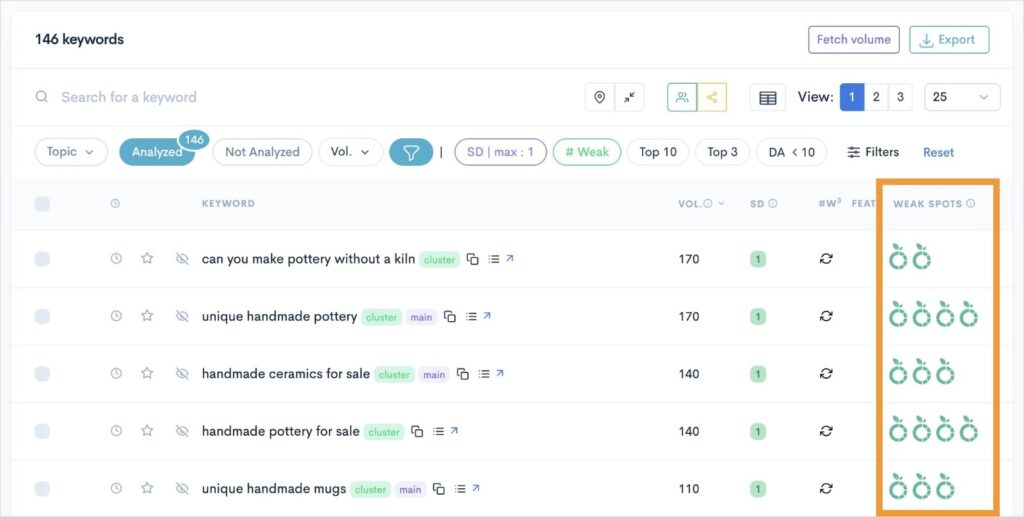
Keywords with low SDs and multiple weak spots are ideal for small websites.
Not only are they easy to rank for, but they also have competitors that you can beat.
This means you can rank high in search results and drive qualified traffic to your site.
Because of this feature, I prefer LowFruits over Semrush when researching keywords for clients with small businesses or newer domains.
What’s Next: Align Content With Buyer Intent
Now that you have a comprehensive list of buyer intent keywords, it’s time to optimize your website for them.
Your content creation efforts should align with the user expectations of each search intent.
Let’s look at some content format examples for commercial and transactional keywords:
Content for Commercial Keywords:
- Comparison guides: Showcase your product or service against competitors.
- Product reviews and testimonials: Highlight customer satisfaction and product benefits.
- How-to guides and tutorials: Demonstrate expertise and provide value to potential customers.
- Case studies and success stories: Showcase your product or service in action.
Content for Commercial Keywords:
- Product pages: Provide detailed information about your product or service, including features, benefits, pricing, and images.
- Landing pages: Focus on a single goal on each page, such as generating leads or driving sales.
- Discount code pages: Communicate discounts and special offers to create a sense of urgency.
If you want to ensure maximum visibility for your content, I also recommend using a content optimization tool.
SEOBoost is a great option for websites of any size.
You write your content in a dashboard similar to Microsoft Word or Apple Pages, so there’s no learning curve. The tool then populates keyword suggestions next to your post or page.
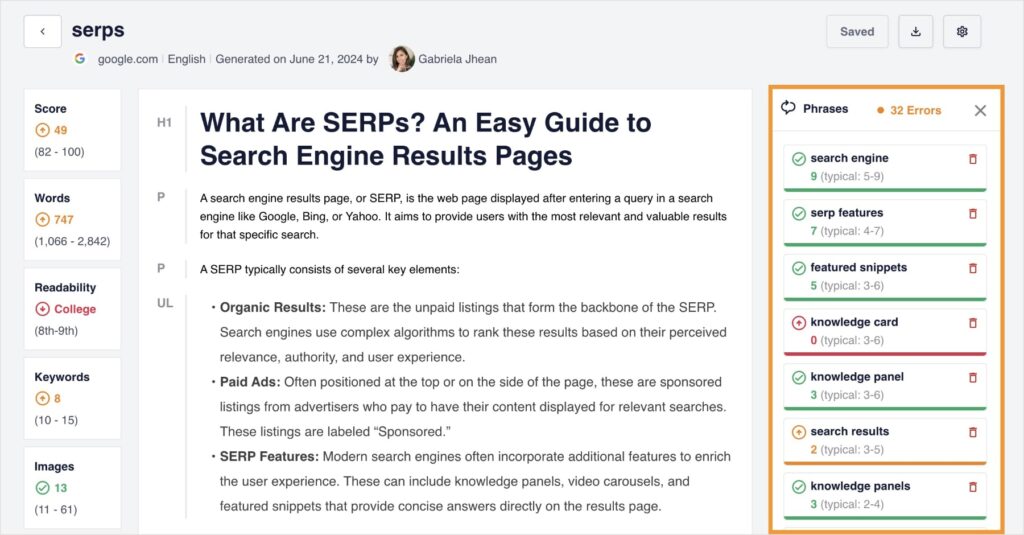
For WordPress users, I highly recommend All in One SEO (AIOSEO).
This SEO plugin generates on-page SEO recommendations directly in the WordPress editor, so you don’t have to switch between tools.
It’s extremely user-friendly and provides actionable checklists to improve your content’s performance.
Here’s an example of the Focus Keyphrase Checklist that analyzes your content for your primary keyword:
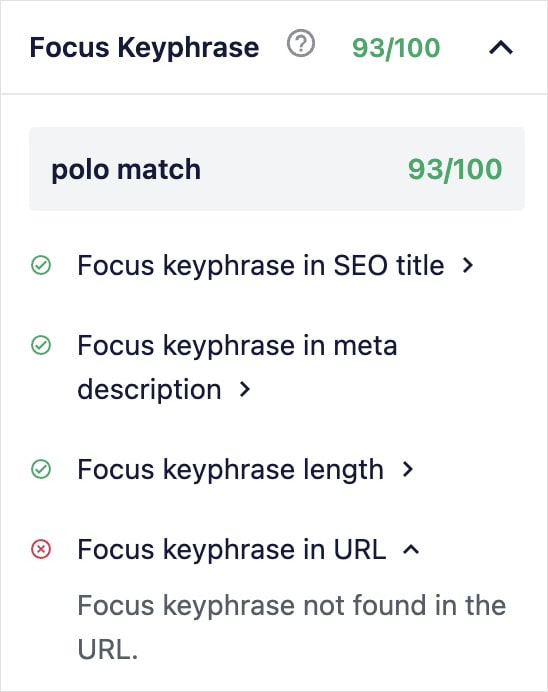
Final Thoughts
Understanding and leveraging buyer intent keywords is essential for driving traffic, generating leads, and boosting conversions.
By aligning your content with the specific needs and desires of your target audience, you can create a more effective and engaging online presence.
Remember, buying intent is dynamic and can evolve over time.
Continuously monitor keyword trends and adjust your strategy accordingly. This approach will help you maximize your return on investment and support long-term growth.
Further reading: